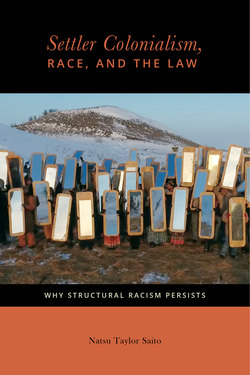Читать книгу Settler Colonialism, Race, and the Law - Natsu Taylor Saito - Страница 27
На сайте Литреса книга снята с продажи.
Internal Colonialism
ОглавлениеOne can see from this very rudimentary description of classic colonialism that there are many similarities between the experiences of colonized peoples around the world and peoples of color in the United States. These parallels explain why scholars and activists have described racialized Others within the United States as internally colonized and why that characterization has a compelling resonance. There are, however, conceptual limitations to a model that relies extensively on analogies derived from political, economic, and cultural contexts that are structurally distinct from the situation at hand.
In a seminal work published in 1975, sociologist Michael Hechter employed the Gramscian concept of internal colonialism to explain the disparities attending economic development within the British state. For Hechter, internal colonization results from a “spatially uneven wave of modernization” that produces an “unequal distribution of resources and power” between “relatively advanced and less advanced groups.”60 The dominant group uses its power to monopolize and institutionalize its privilege, creating a system of social stratification—what he terms “a cultural division of labor”—that reinforces ethnic identification.61 As with classic relations between metropolitan centers and their colonies, power resides in the core and is “characterized by a diversified industrial structure,” while “the pattern of development in the periphery is dependent, and complementary to that in the core.”62
Hechter illustrates how a framework that acknowledges colonial exploitation can explain, in structural terms, the illusory nature of the presumption that internal “minorities” will inevitably, if gradually, be fully incorporated into a unified state. This latter perspective, the diffusion model, predicts that economic disparities will decrease and cultural differences become less significant over time. In this respect it is much like the models of assimilation or multicultural pluralism prevalent in the United States today. The internal colonial model, on the other hand, predicts that economic inequities will persist or increase, “peripheral culture” will be more strongly asserted in reaction to “domination by the core,” and “political cleavages will largely reflect significant cultural differences between groups.”63 These are, of course, developments we have seen within the United States.
The models’ divergent predictions result from their differing analyses of structural and institutional dynamics, and they lead us toward distinct—indeed incompatible—remedial options. Hechter’s analysis suggests that people of color in the United States might appropriately be characterized as internally colonized and that the disparities between privileged and subordinated groups will not be eliminated until the underlying institutions and political relations have been decolonized. Nonetheless, this is a model derived very directly from, and reliant upon, the conceptual framework of external colonialism. Its geographically oriented core/periphery distinction is of limited applicability in settler societies that, as historian Norbert Finzsch notes, “have no periphery and no core, since the capital-owning elites in the cities and the social actors on the frontier form one complex interactive community.”64 Further, its framing of colonization primarily in terms of economic exploitation and underdevelopment reflects a very Western, linear notion of progress that disregards the fact that contemporary goals of “development” and “modernization” are, themselves, colonial impositions.
Internal colonization is a construct critical to understanding contemporary struggles for self-determination within “postcolonial” states whose boundaries now encompass multiple preexisting nations. However, to the extent that internal colonialism is understood as a derivative of external colonialism—as it was by many US activists of the 1960s—it is of limited utility in explaining or remediating settler colonial exploitation. In settler societies, there is no geographically distinct metropolitan “mother country” or “core” to which the colonizers may retreat, and the full incorporation of subordinated peoples would simply consummate their colonization.65 Recognizing internal colonialism gives us a starting point for understanding that racial subordination in the United States is deeply, structurally embedded. Pursuing that analysis, however, requires us to acknowledge that settler states represent a distinct form of contemporary colonialism.
